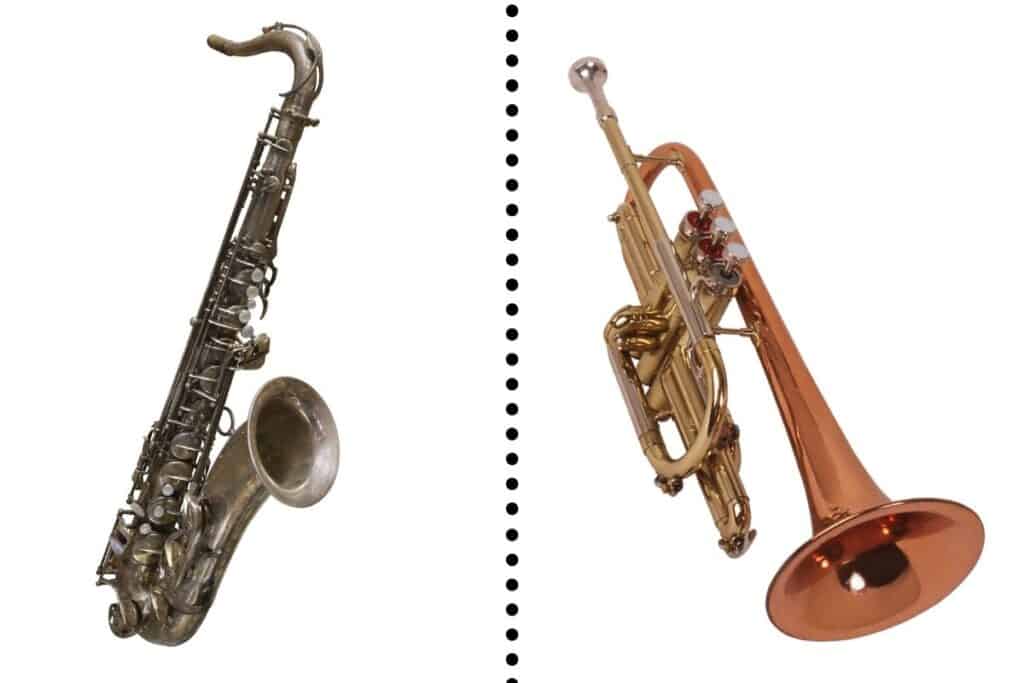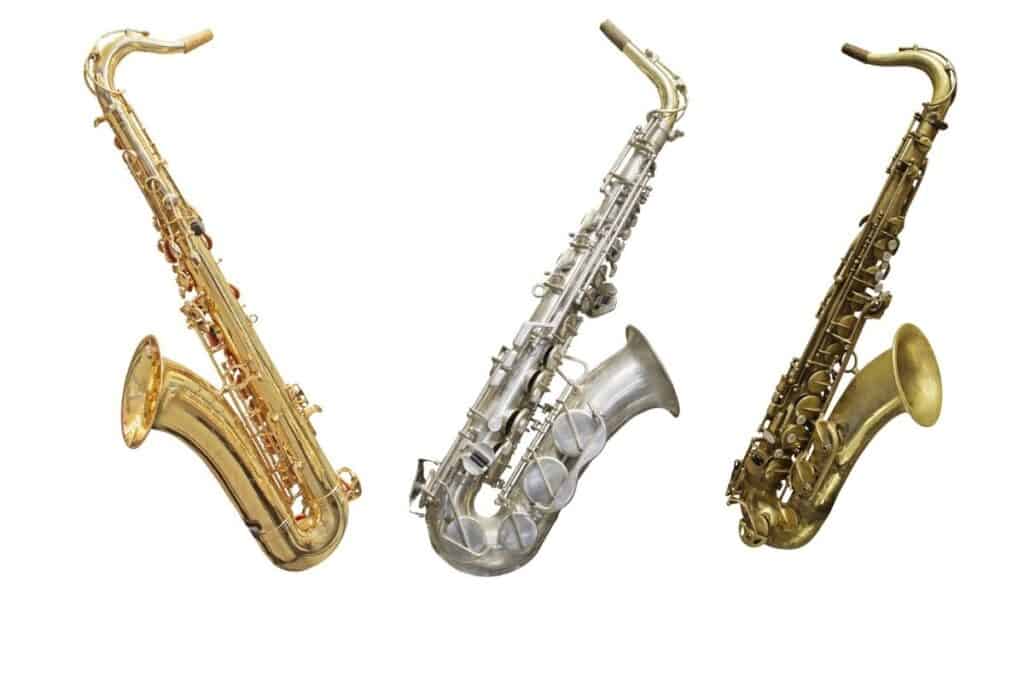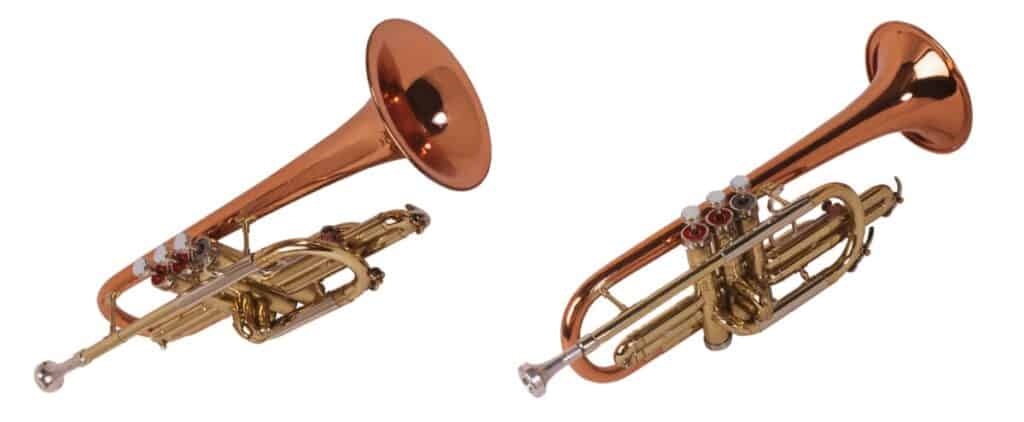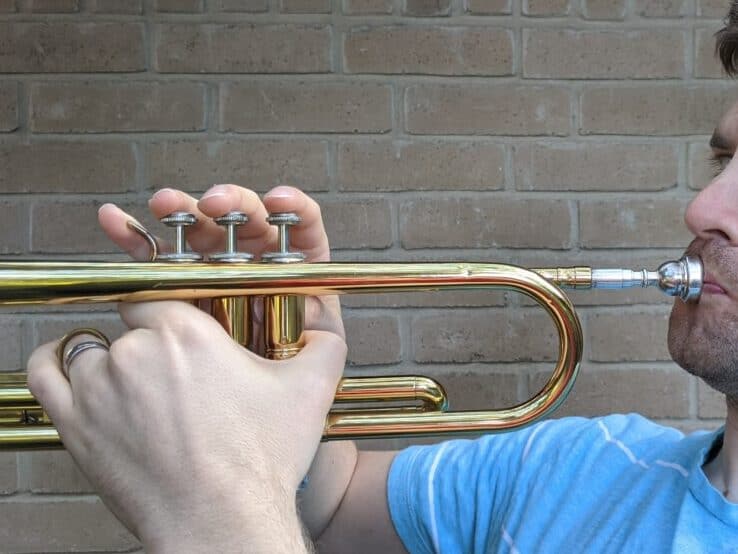This post contains affiliate links. We earn commissions if you purchase products from retailers after clicking on a link from our site. As an Amazon Associate, we earn from qualifying purchases.
You’ve heard about the trumpet and the saxophone, but perhaps you’ve never thought about what’s different (or what’s the same about both instruments). I’ll clarify any questions you have.

By the way, looking for recording equipment and musical instruments? Check out Sweetwater.com for microphones, monitors, audio interface or any other recording gear that you could ever need. (Affiliate Link)
Differences Between the Trumpet and the Saxophone
| Attribute | Trumpet | Saxophone |
|---|---|---|
| Instrument Family | Brass | Woodwind |
| Sound Creation | Player’s lips by “buzzing” | Air over a wooden reed |
| Average Cost | ~$2450 | ~$5400 |
| Material | Curved Brass Tubing, sometimes Silver-Plated | Curved Brass Tubing, Sometimes Silver Plated |
| Sound projection | Trumpet projects from players face outwards | Alto, Tenor, and Baritone Saxophones project upwards from player’s midsection from bell in an elbow shape |
| Held In Place By | Player’s hands | Stabilized by player’s hands but often has a strap that goes around the player’s neck for more comfortable playing |
| Sounds Shaped By | Player’s lips, and by opening and closing parts of the tubing via depressing 3 valves | Breath and multiple keys (around 20) can be depressed that allow air to escape the saxophone tubing and change the tubing. |
Trumpets and saxophones have many differences and similarities. I’ll share the most important differences as well as the similarities, and by the end you’ll have a great understanding of the two instruments.
The Differences Between the Saxophone and the Trumpet
Alright, let’s get to the pictures! Pictures say a thousand words, and I’ll let them do the talking.
Visual

The saxophone has a mouthpiece which fits onto cork (as you can see in the picture) which attaches the mouthpiece to the main tube of the instrument.
The saxophone’s main tube that is perpendicular from the mouthpiece, and is covered with keys which open various valves along the main tube and on the bell of the saxophone.
The bell of the saxophone is the opening of the saxophone that flares out (think of a bell that you have seen and you’ll see this kind of flaring). The bell is angled up and out and helps the sound project into the room as it is played.
Trumpet

The large flaring part of the metal is called the bell of the instrument. The trumpet is played by the player buzzing their lips into the (often silver-colored) mouthpiece which is inserted into the main bore of the trumpet.
The trumpet is essentially a long brass tube that is curved in such a way to be compact. There are multiple pipes that extend the length of the tube that are made accessible by the 3 valves that are in the center of the instrument.
The changing of the length of the tube changes the trumpet’s resonant frequencies. The trumpet can resonate at several frequencies, so it can play any note by changing the speed of vibration (i.e. the players’ lips).
Sound
So the trumpet and the saxophone look different. So what? Perhaps what you’re really wondering is the differences in how trumpet and saxophone sound. Let’s take a listen!
Saxophone
Here’s an example of what the saxophone sounds like:
The saxophone is characterized by smooth tones, meaning there isn’t a sharp transition between notes. If the sound of a saxophone could be put into a food, it’d probably be honey.
In seriousness, though, the saxophone really does have a huge variety of sounds it can make, from smooth to growling and squealing according to what the song calls for.
Trumpet
Here is an example of what the trumpet sounds like:
Trumpets can shout, they can scream, and they can sing. It’s an incredible instrument with a beautiful sound.
Tonguing
I actually tried to compare the difference in sound between a trumpet and a saxophone and it’s actually very difficult! It’s kind of like trying to describe the taste of salt.
But one thing that is different between the two is the sharpness of articulation. Trumpets and saxophones have legato staccato forms. (these are just fancy words for saying how short the note is played and how a note is approached. Is it played quick and sharply? Or smoothly, etc)
However, no matter what, the sound of the very beginning of a note sounds different comparing a saxophone and a trumpet. A trumpet’s attack can be sharper and more pronounced–kind of like the sound praow, while a saxophone sound more like hum.
It’s subtle, but if you listen for a while, you’ll always be able to pick out a trumpet from a saxophone, and vice versa.
Categorization
Trumpets and saxophones are in different instrument families, but they are in the same instrument classification.
Trumpets and saxophones are both aerophones, which means they make sound by a vibrating air column.
Trumpets are brass instruments. Saxophones are considered woodwind instruments. It turns out that brass and woodwind have nothing to do with the material of the instrument–it’s mostly a historical definition than anything.
Both trumpets and saxophones are referred to occasionally as horns–even though they make their sound very differently.
How It’s Played
Let’s talk about how the instrument is held and actually played.
Saxophone
The saxophone is held and stabilized by the player’s hands which also press the keys along the main tube of the instrument. Because this is a requires some stability, most saxophonists play with a strap that goes around the neck of the player which keeps the saxophone suspended while the player can press the keys.

The saxophonist is blowing air through over a reed to make the sound. Pushing the keys themselves doesn’t make the sound, but rather a combination of shaping the sound with opening and closing valves through pressing keys. I’ll talk about that more in the embouchure section.
Trumpet
The trumpet is traditionally held (there are left-handed models) with the left hand. The ring finger of the left hand typically reaches around the 3 valves with the thumb with the ring finger fitting into a ring that is attached to a slide (for per-note tuning purposes) on the other side of the 3 central valves.

The right hand depresses the 3 valves–the pointer, the middle, and ring fingers are usually given this job.
If needed, the trumpet can be held solely by the right hand by the help of a hook on the main bore of the trumpet and by hooking the thumb around the bore.
Embouchure and Sound Formation
One crucial difference between the trumpet and the saxophone is how the sound is created, and the necessary embouchure to do so.
What is an embouchure? It’s a fancy term for your face! And your lips, and mouth, and cheek muscles all working together to produce the sound of an instrument. Any wind instrument requires some sort of embouchure. It’s just a way to narrow down and talk about the sound-making mechanism that is hugely important in making music.
Trumpets and saxophones have fundamentally different embouchures. They’re not even in the same city much less the same ballpark!
Let me try to summarize the two different embouchures of the trumpet and saxophone and how they make the sound of the instrument.
- Trumpet players use their lips to buzz (imagine imitating the sound of a fly with your lips, that’s kind of what trumpet players do to make the trumpet sound). The vibration of the air comes from the lips of the trumpet player.
- Saxophone players blow into a mouthpiece and over a (typically wooden) reed which is attached to the mouthpiece with a ligature. (you can think of a ligature as a reed clamp). The reed vibrates and causes the air to vibrate and the air column inside the saxophone to vibrate.
In short, the trumpet makes their sound by buzzing their lips, and saxophones blow over a wooden reed which makes the sound of the saxophone.
Trumpet Embouchure
The trumpet embouchure is very different than the saxophone embouchure because the lips need to buzz in a small focused area (the centerish of the lips). The corners of the lips are kept pulled in and tight to help focus the sound and keep the air within thee mouth pressurized as the air pressure varies to increase or decrease pitch.
If it sounds complicated to you, you are right! It is complicated and difficult. In fact, trumpet players have to continuously be playing to keep the extremely fine coordination required to play the trumpet. If a player stops playing for even a few days there is a retraining that’s necessary to keep their embouchure (or chops as many say) in shape.
Saxophone Embouchure
The saxophone embouchure is created by making a seal around the mouthpiece. The bottom lip is used to control and anchor vibration of the reed.
Saxophonists have to fine tune how to make the perfect seal, how to put the proper amount of mouthpiece in the mouth and the proper breath support necessary to vibrate the reed.
The saxophone embouchure takes ages of practice to get a really good sound (as is true with most wind instruments), but is a bit more straightforward than the trumpet embouchure.
Similarities Between the Saxophone and the Trumpet
There’s a lot that’s different between the saxophone and the trumpet, but there are a lot of similarities as well.
What’s kind of funny about saxophonists and trumpet players is there is an ever-ongoing rivalry. Kind of like your high school and the nearest town. But, let’s talk about what is similar to each instrument and try and make peace.
Material
It turns out that the trumpet and the saxophone are both made from brass. Either instrument can be gold or silver-plated, but the core of the instrument is brass.
There are some slight differences here. The saxophone also has leather pads to seal the holes, and also uses cork for the mouthpiece, as well as wood for the reed (often made from giant cane).
The trumpet also uses cork for the water valves (otherwise known as the spit valves. Gotta get that stuff out somehow).
Styles of Music
The trumpet and saxophone are actually used in a lot of the same music styles. Classic orchestral music prominently feature the saxophone and trumpet. The same for contemporary orchestral.
Both the trumpet and saxophone make up a significant part of the soul of jazz music. Add some drums and a bass player and you have a jazz combo (a small jazz band).
Both saxophone and trumpet find their ways into pop music. The saxophone, for example is in Dave Matthews Band and in some of Céline Dion’s music, among thousands of other bands. The same for the trumpet!
If you want to see how saxophone lands in modern music, check out Moon Hooch–which features 2 saxophones and the drums. Who thought that could be a band? They do a tremendous job, too.
Range
Another interesting similarity is that the trumpet and the saxophone are in similar ranges. the saxophone comes many different sizes, the most common being alto and tenor and baritone, but also in the smallest size soprano. The soprano is the highest of the saxophones, but even it is not too far off from the pitches possible on the trumpet.
The range of the trumpet and the saxophone are similar to the range of the human voice, which could be one reason why they sound so great to our ears.
Difficulty In Mastering
Both the trumpet and the saxophone share another characteristic–they are both career instruments that are difficult to master. It takes years of consistent practice to reach expert level on the trumpet or the saxophone.
Whatever you feel about the saxophone or the trumpet, they are both serious instruments that you can dedicate your music life to.
Is Saxophone Harder Than Trumpet To Learn?
This is a great question with a complicated answer. I found this really interesting article talking about how a music teacher found that their saxophone students were getting the fundamentals of the saxophone faster than the other band members because of how much easier it is to start learning the saxophone than other instruments.
To counter this, the music teacher required students to spend a year learning another instrument and could only play the saxophone afterwards. To see more about this music teacher’s experience, it can be found here on their blog nottelmannmusic.com.
But does that mean that the saxophone is easier than the trumpet?
In some aspects, and some no. The trumpet player has a super hard challenge with their embouchure which is something they have to carefully build and maintain throughout their music career. The saxophonist doesn’t have the same challenges, but there are advanced techniques that it takes countless hours to hone.
I go into more detail about what aspects of the saxophone are easier and what aspects are harder in my post here. You may find some surprising information that might change your mind on this!
